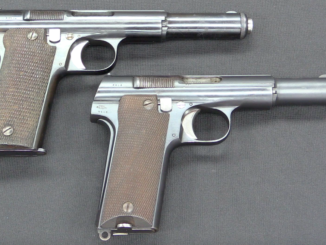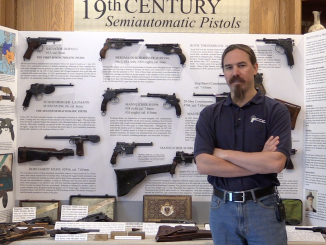The Llama M82 was adopted as the new Spanish Army service pistol to replace aging Star Model B pistols. The design of the side is mechanically almost identical to a Beretta 92, while the frame and controls include a lot of DNA from the commercial Llama Omni. It was adopted in 1986, with the first military deliveries taking place in 1987.
Related Articles

Semiauto pistol
Astra 600/43: A Straight Blowback 9mm for the Wehrmacht
The Astra in this video is coming up for auction here… When Germany acquired a land border with Spain after the French capitulation in 1940, they took advantage of the opportunity to purchase Spanish firearms, […]

Select-fire Rifles
French Marine Commandos with CETME Rifles
I was doing some reading up on the early roller-delayed rifles (in Blake Stevens’ exquisitely technical and detailed book Full Circle: A Treatise on Roller Locking) and came across this very cool story, which I […]

Semiauto pistol
Special Presentation: Semiauto Pistols of the 1800s
Today’s Special Presentation is an overview of all the semiautomatic pistols that were actually put into serial production before the year 1900. We have looked at these individually before, but I think it is worthwhile […]

Awesome segment Ian! I have an M87 and an Omni III along with a Star 31, and an A-100. The differences between the M87 and the Omni are shocking. For me the Omni is a mess, whereas the M87 is really pretty good.
Of course doing what South Africa did in producing the Denel M88 and Vektor SP1 would have been much too simple.
clear ether
eon
“(…)Denel M88 and Vektor SP1(…)”
According to http://modernfirearms.net/en/handguns/handguns-en/spain-semi-automatic-pistols/llama-m-82-eng/
Safety is mounted on the slide and when activated, it moves the firing pin out of the reach of the hammer and locks it, and then decocks hammer and also disconnects the trigger bar. safety does not affect slide, so slide can be cycled and cartridge chamvered with the safety “on”, but hammer will not stay in the cocked position. After that, when safety will be disengaged (“off”), gun will be ready to fire first shot in Double Action. All consequent shots will be fired in Single Action Mode. If one desires, he also can manually cock the hammer for the first shot, to improve accuracy.
Could any of above mentioned do so?
That pretty much describes the way the Walther-type “hammer drop” safety has worked going back to the PP in 1925. No matter who makes the gun it’s on.
Incidentally, racking the slide with the safety on means that the hammer will “follow down” to the uncocked (double-action) position as the slide goes into battery. Which means that it is “hammering” on the slide’s shoulders that prevent it from striking the rear of the firing pin.
Do that enough on something like a wartime production P.38, and eventually those shoulders will fail due to metal fatigue, and when you do it again (or just apply the safety normally to “drop” the hammer) the piece will fire.
The Walther safety is “institutionalized” on double-action automatics after a century of use by almost every manufacturer of same. But no amount of examples can make it a particularly good idea.
cheers
eon
The Walther PP safety puts a metal bar between the firing pin and the hammer, and the hammer hits that bar.
The Walther P38 safety locks the firing pin. The hammer still hits the firing pin, but it can’t go forward.
The Beretta safety rotates the tail of the firing pin out of the reach of the hammer. With the firing pin rotated, the hammer doesn’t reach anything of it, and hits the slide.
Any not-slide-mounted decocker cecocks only to half-cock. That means the energy of the hammer is not transferred to a metal bar, a locked firing pin or the slide, but to the edge of the sear. Hardly a better idea.
The P.38 safety is noted for the “drum” fracturing with age, allowing the hammer drop’ to fire the pistol. that’s why people experienced with the P.38 lower the hammer carefully with the left thumb while applying the safety with the right. I did it that way for thirty years.
The Beretta version can also fire the piece with age and metal fatigue. In fact there was a JSSAP notification on that exact subject in 1998, along with a product recall warning from Beretta USA.
Decockers as a rule are a bad idea. The ones that only go down to half-cock like the SiG or H&K USP leave the hammer “safed” only by the half-cock notch, which is as potentially dangerous as it is on a 1911 or a Colt Model 1873 for that matter.
The proper carry position for a “conventional” double-action-trigger anything is hammer all the way down.
Please note that systems like the Glock or Ruger LCP are emphatically not “conventional” double-actions. For the most part, they are slightly-updated versions of the Roth-Sauer (Krnka-Roth) M1907 action.
cheers
eon
They are not only as potentially dangerous as it is on a 1911 or a Colt Model 1873.
In a Colt 1911, or a Colt model 1873, you pull the hammer to half cock, and leave it there. The hammer doesn’t hit the half cock sear, charged with kinetic energy, every time you decock.
The half-cock on those is purely to prevent the hammer from hitting the firing pin or primer if your thumb slips while thumbing the hammer back. It is not a safe carry mode and was never intended to be.
The only really safe modes in the Colt or similar Browning type self-loaders are either hammer fully cocked, safety on (Condition One), hammer down on loaded chamber (Condition Two) or hammer down on empty chamber (Condition Three).
The only really safe mode on the revolver is hammer down on an empty chamber.
It’s been that way for over a century in each case. The laws of physics and mechanics have not changed in that time and are not going to change in the future.
cheers
eon
Does the line really go Beretta–>M88/Vektor SP1, or does it actually go M82/Beretta–>M88/Vektor SP1?
I find it a lot easier to believe that the tech transfer came from desperate and nearly bankrupt Spanish companies happened than from Beretta, who had to keep the US sweet because of the M9 contract… Although, it’s not like the South Africans were slouches at small arms design, either.
Lots and lots of weird things happened, surrounding the South African sanctions regime. I’ve been told by people that the so-called “Vela Incident” was, indeed, the result of South African and Israeli validation testing of nuclear weapons. Also, that there was informal delivery of film from those test results to certain capital cities… Along with casual US verification, delivered very dryly, that “This happened… Just sayin’…”
The sanctions were pretty damn permeable, in some ways. There’s really no telling without seeing the documentation and all the rest of the background information on all of it. What irritates me is that it was so one-way… The US should have been glomming onto the MRAP and route-clearance stuff as soon as it was developed, but we studiously ignored it. Bad, evil racist Rhodesia and South Africa developed it, so it couldn’t be either useful or any good…
I think it was Beretta USA>US State Department>probable NSA>Lyttleton Engineering Works (the original “designers” of the M88).
M88 was just a little too close to M92FS/M9PIP for coincidence. Especially starting out with the oversize hammer pin head to prevent “SEAL slide syndrome”. Sensible as SA issue 9 x 19mm was pretty hot for use in SMGs.
Truvelo Armory’s Milkor BXP was a little too close to the Cobray M11 to be just a coincidence, too, and it arrived at about the same time.
cheers
eon
Provenance in small arms design is like trying to work out virginity and virtue at a whorehouse, TBH. For examples, see Othais over at C&Rsenal’s progression into insanity as he tries to trace out the reality of 19th Century revolver design…
It’s about like the “tactical nylon” industry, and trying to work out who the hell designed the now-ubiquitous tear-drop “assault pack”. I have a Gregory Day-and-a-Half pack that matches the early Eagle and London Bridge rucks to an improbable degree, and they’re all like oversize versions of the Jansport day pack that everyone carried to school. Figure out the family tree, design-wise, there… You’ll lose your bloody mind.
It’s entirely possible that the M88 and the Vektor were clean-sheet designs, but I have to kind of doubt that they were. Just like with teasing out the various factors going into the AK design, it’s a source for endless discussion, argument, and theorizing.
So, if nothing else? Are we not entertained?
I know JMB and FN-Liege were not at all entertained by all those “Eibar”- made Browning M1910 knockoffs. Even though some of them were actually not too bad, although the French MAB Model D was considerably better. The threaded-in bushing at the front end made more sense in my estimation.
cheers
eon
Is there such a debate?
To me they always seemed camo versions of the backpacks I used for school since the ’80s.
“The sanctions were pretty damn permeable” Russia is proving that as we speak
During Cold War Soviet Union was able to acquire machines for production of submarine screw from Japan and Norway (observe 2nd is one of NATO primal dozen), for more data see https://www.globalsecurity.org/intell/world/russia/toshiba.htm
The adoption of the Llama M82 as the Spanish Army’s new service pistol in 1986 marked a significant upgrade from the aging Star Model B pistols. With a mechanical similarity to the Beretta 92 and incorporating elements from the Llama Omni, it proved to be a modern choice. Deliveries commenced in 1987.